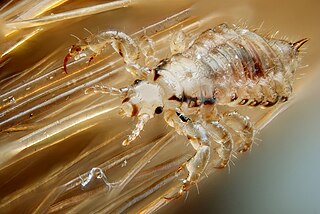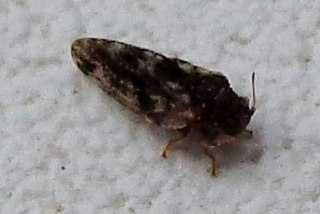
The head louse is an obligate ectoparasite of humans. Head lice are wingless insects that spend their entire lives on the human scalp and feed exclusively on human blood. Humans are the only known hosts of this specific parasite, while chimpanzees and bonobos host a closely related species, Pediculus schaeffi. Other species of lice infest most orders of mammals and all orders of birds.

Psyllidae, the jumping plant lice or psyllids, are a family of small plant-feeding insects that tend to be very host-specific, i.e. each plant-louse species only feeds on one plant species (monophagous) or feeds on a few closely related plants (oligophagous). Together with aphids, phylloxerans, scale insects and whiteflies, they form the group called Sternorrhyncha, which is considered to be the most "primitive" group within the true bugs (Hemiptera). They have traditionally been considered a single family, Psyllidae, but recent classifications divide the group into a total of seven families; the present restricted definition still includes more than 70 genera in the Psyllidae. Psyllid fossils have been found from the Early Permian before the flowering plants evolved. The explosive diversification of the flowering plants in the Cretaceous was paralleled by a massive diversification of associated insects, and many of the morphological and metabolic characters that the flowering plants exhibit may have evolved as defenses against herbivorous insects.

Casuarina, also known as she-oak, Australian pine and native pine, is a genus of flowering plants in the family Casuarinaceae, and is native to Australia, the Indian subcontinent, Southeast Asia, islands of the western Pacific Ocean, and eastern Africa.

The Sternorrhyncha suborder of the Hemiptera contains the aphids, whiteflies, and scale insects, groups which were traditionally included in the now-obsolete order "Homoptera". "Sternorrhyncha" refers to the rearward position of the mouthparts relative to the head.

Psylloidea is a superfamily of true bugs, including the jumping plant lice and others which have recently been classified as distinct families. Though the group first appeared during the Early Jurassic, modern members of the group do not appear until the Eocene, and Mesozoic members of the order are usually assigned to the possibly paraphyletic family Liadopsyllidae.
Eurotica is a genus of jumping plant lice in the subfamily Aphalarinae and tribe Xenaphalarini, erected by Loginova in 1962.

Triozidae is one of seven families collectively referred to as jumping plant lice. They have traditionally been considered part of a single family, Psyllidae, but recent classifications divide the group into a total of seven families; most of the genera remain in the Psyllidae, but Triozidae is the third-largest family in the group, containing 27 genera, and a number of pest species.

Aacanthocnema is a genus of bugs from the jumping plant lice family (Triozidae). The genus is endemic to Australia, and currently contains six species, found in all states and territories with the exception of the Northern Territory.

Aphalaridae is a bug family in the superfamily Psylloidea.

Homotomidae is a family of small phloem-feeding bugs in the superfamily Psylloidea, or jumping plantlice.

Phacopteronidae is a family of bugs in the superfamily Psylloidea.
Rhinocolinae is a subfamily of insects in the family Aphalaridae.

Aphalara is a genus of jumping plant lice (psyllid) in the family Aphalaridae.

Aphalarini is a tribe of jumping plant lice (psyllid) in the subfamily Aphalarinae, first described by Franz Löw in 1879.

Anthocoris nemoralis is a true bug in the family Anthocoridae. The species is native to Europe and is introduced in North America. It is a predator of aphids, spider mites and jumping plant lice, and is therefore used as a biological pest control agent.
Calinda muiscas is a species of jumping plant lice of the genus Calinda in the family of Triozidae. The species was first described in 1997 by Olivares and Burckhardt.
Aacanthocnema burckhardti is a species of jumping plant lice, first found as a sap-sucker on plants of the genus Allocasuarina in Australia. The species is characterised by exhibiting an elongate habitus; short Rs and short cubital forewing cells; ventral genal processes beneath the apical margin of its vertex; short antennae; and nymphs that are elongate and very sclerotised (scale-like). It lacks hinaria on its eighth antennal segment as well as sclerotised spurs on its hind tibia. Females of the species lack a posterior apical hook on their proctiger.
Aacanthocnema huegelianae is a species of jumping plant lice, first found on plants of the genus Allocasuarina in Australia. The species is characterised by exhibiting an elongate habitus; short Rs and short cubital forewing cells; ventral genal processes beneath the apical margin of its vertex; short antennae; and nymphs that are elongate and very sclerotised (scale-like). It lacks hinaria on its eighth antennal segment as well as sclerotised spurs on its hind tibia. Females of the species lack a posterior apical hook on their proctiger.
Acanthocasuarina is a genus of bugs from the jumping plant lice family (Triozidae). The genus is endemic to Australia, and currently contains six species.

Liviidae is a family of plant-parasitic hemipterans in the order Hemiptera, with about 19 genera.














